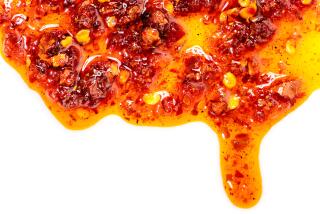ROUNDING UP THE FACTS ON RANCH DRESSING
- Share via
Restaurant salad dressings around here used to come in roughly four basic flavors-- blue cheese, vinaigrette (or simply oil and vinegar), French (which is about as French as English muffins are English), and Thousand Island (which is basically Russian dressing and was, I suspect, given its Canadian/American name in some fit of culinary jingoism).
Italian dressing, which is more or less oil and vinegar with herbs and usually garlic added, was sometimes No. 5. Green Goddess dressing (an invention of the Palace Hotel in San Francisco, consisting of mayonnaise with anchovies and green herbs) enjoyed some success in Southern California in the ‘50s and ‘60s, but today its habitat is pretty much limited to old-fashioned prime rib restaurants.
Other dressings, involving Parmesan or feta cheese, honey, soy sauce, etc., have remained only sporadically popular.
One salad dressing that started out with strictly regional appeal, though, seems on the brink of becoming a full-scale American gastronomic phenomenon. I speak of the slightly sour, creamy, garlicky dressing called “Ranch”--which may currently be found at just about every salad bar in the nation, and which has now appeared as a flavoring for corn chips--in the person of “Cool Ranch-Flavor Doritos.”
What is Ranch dressing, and where did it come from? That’s what I wanted to know, and so I sent a query to the letters page of Nation’s Restaurant News asking for help in tracking down the facts. I promptly received a reply from Jerry L. Law, vice president of Central Commissary, Inc., “The ‘Soup’r’ Dressings People,” from Glendale, Ariz.
Ranch dressing, he wrote, was created in 1980 by David Bears of Todds, a division of Central Commissary, expressly for the Bobby McGee’s restaurant chain, “to be used as a dipping sauce for their in-house breaded and deep-fried zucchini.” The dressing, Law says, is made from freshly ground onions, fresh parsley and garlic, real mayonnaise and “thick, rich buttermilk with special seasonings.”
I thought this all made quite a bit of sense--until I got a second letter, this one from Bud Cohen, Clorox Co. communications specialist. Ranch dressing, he said, was invented at least 40 years ago by a family by the name of Henson, who owned Hidden Valley Ranch, a guest-spread in the San Marcos Pass near Santa Barbara. Responding to requests from ranch visitors who liked their homemade salad dressing, the Henson’s started packaging it in dry mix form, with buttermilk to be added, and selling it “mostly to the Western states in the period between the end of World War II and the early 1970s.” Clorox bought all rights to the product in late 1972 and, since that time, has marketed it under the Hidden Valley Ranch original ranch dressing label.
Clorox describes the dressing as “a very mild (not tart) salad dressing with a decidedly fresh dairy background, with overtones of mayonnaise, egg, onion and herbs which rapidly clears away from the pallet.”
The Hidden Valley Ranch, incidentally, is now the Hidden Valley Retreat Center, and the Hensons are long gone. And just how much of the ranch dressing you find in salad bars today actually belongs to Hidden Valley is anybody’s guess.
MORE WOMEN CHEFS: The Association des Restauratrices-Cusinieres is a French-based group of female chefs and chef-restaurateurs, counting some 55 members in France and a handful in Britain, Belgium, Switzerland and even Uruguay. The organization publishes an illustrated guide to member restaurants, listing specialties, prices, and other information--and is also interested in expanding its membership to include American chefs of the female persuasion. Potential members must hold executive chef titles or, preferably, be chef-owners of their establishments. For membership information and/or copies of the guide, contact the group’s U.S. representative, Sylvi C. Brown, 1230 24th Street, Santa Monica 90404.
TABLE SCRAPS: The Loa Jazz Restaurant is new on Pico in Santa Monica, under the ownership of Mariko--described as “Japan’s only woman jazz disc jockey.” . . . The Cinegrill at the Hollywood Roosevelt Hotel has started serving a daily buffet luncheon from 11:30 a.m. to 2 p.m.
More to Read
Eat your way across L.A.
Get our weekly Tasting Notes newsletter for reviews, news and more.
You may occasionally receive promotional content from the Los Angeles Times.










